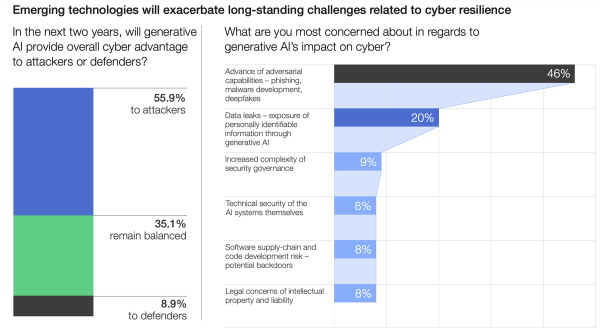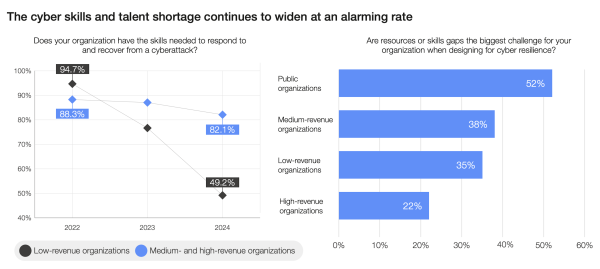What are the biggest cybersecurity trends and threats of 2024? According to the WEF report, a major issue is the widening inequity in cyber preparedness among businesses. Unsurprisingly, AI and its potential to aid bad actors is also a key concern - particularly in a year with over 45 elections taking place around the world.
On the cybersecurity divide:
- A stark divide is emerging between organisations that are cyber resilient, and those that aren’t. The latter group is disproportionately made up of SMEs, with larger organisations able to invest more in cutting-edge technology and training.

Source: WEF Global Cybersecurity Outlook
- Plus, only 25% of small organisations have cyber insurance, compared to 75% of larger ones, meaning they are far less likely to recover from a breach financially.
- Another factor exacerbating this divide is the ongoing skills shortage: half of the smallest businesses state they either don’t have or aren’t sure whether they have the necessary cyber skills within their organisation.
- There’s also a gap between countries in the global north and south hemispheres- Latin America and Africa have far lower numbers of resilient organisations than Europe and North America. Known as the cybersecurity poverty line, this is in large part due to the prohibitively high costs of tech and personnel for lower-income countries.
On geopolitics:
- According to 70% of leaders surveyed for this report, geopolitics has at least moderately influenced their organisation’s cybersecurity strategy.
- The report identifies six areas of risk in this year’s elections: mis-/disinformation, deepfakes, automated disinformation, targeted ads, data privacy concerns, and algorithmic manipulation of social media
On AI-fuelled cybercrime:
- Will AI provide an advantage to attackers or defenders? According to the WEF’s report, AI will provide attackers with an advantage. The biggest concern is that AI will supercharge phishing, malware development and deepfakes.

Source: WEF Global Cybersecurity Outlook
The report states that LLMs could be harnessed for cybersecurity - it can be used for tasks such as classifying data, or to automate looking for threats. But AI cannot replace the creative and nuanced human element of cybersecurity that is essential for combating threats.
On the skills shortage:
- The cyber skills and talent shortage is growing at an alarming rate, especially in public organisations and in small and medium-sized enterprises.

Source: WEF Global Cybersecurity Outlook






